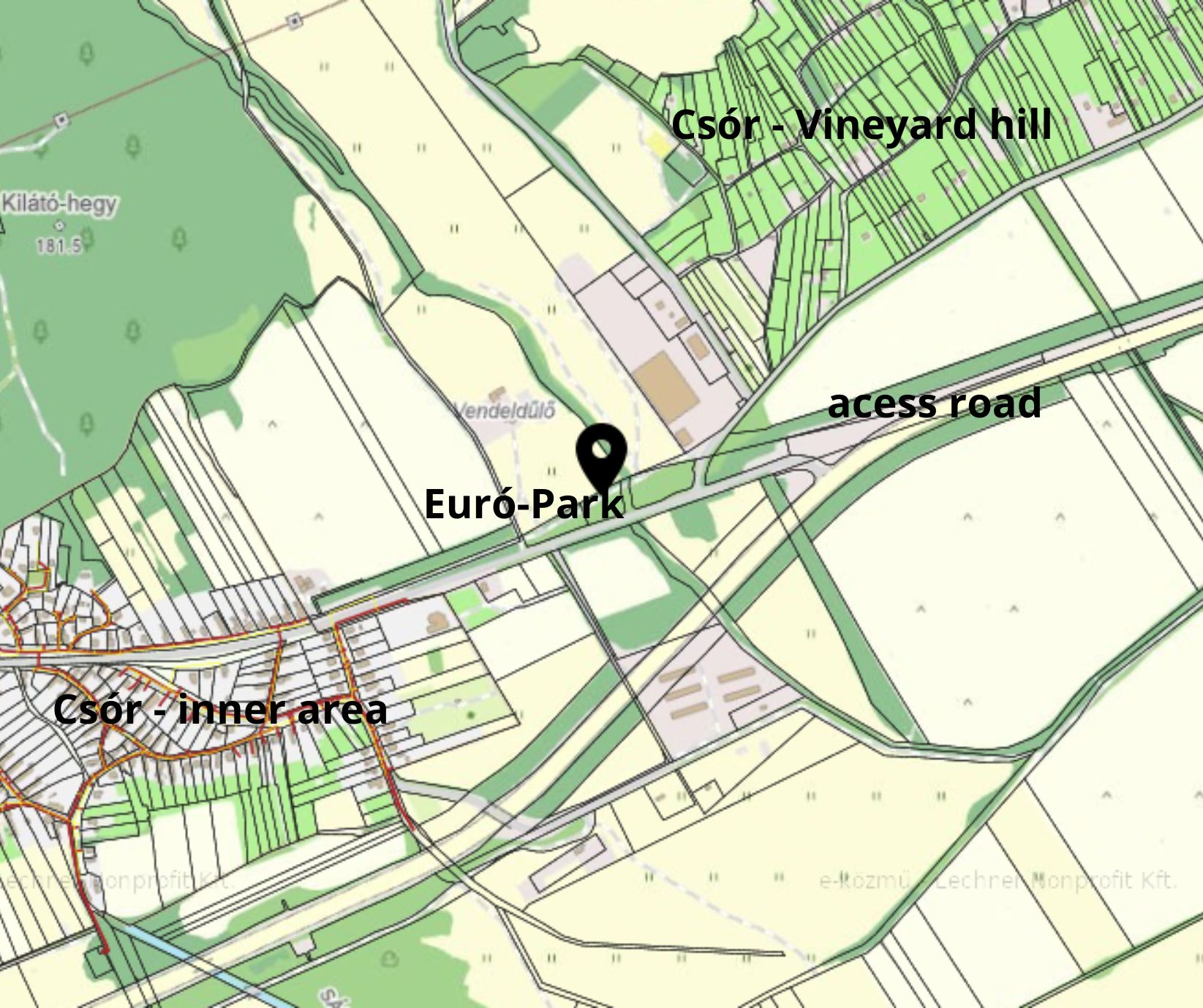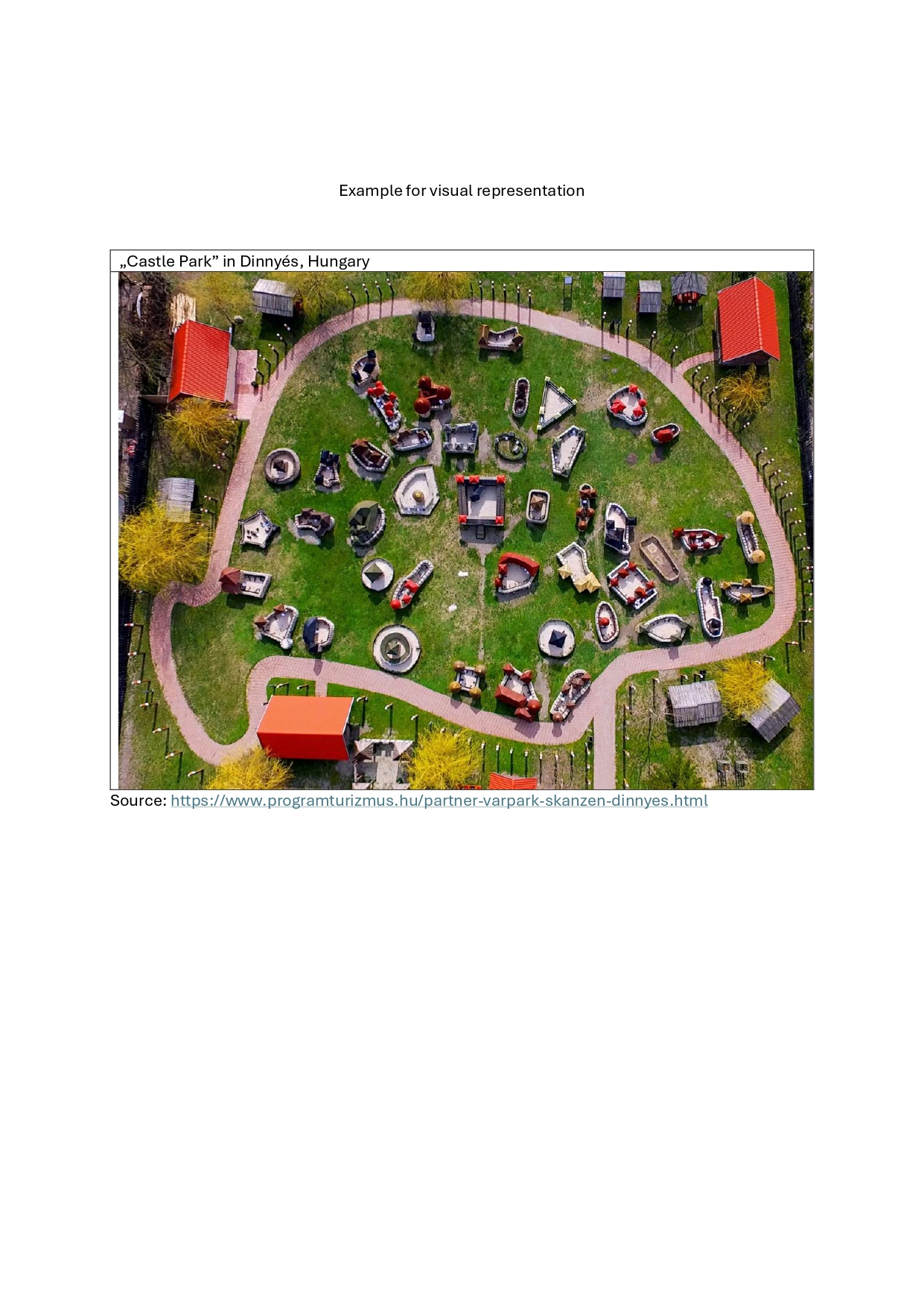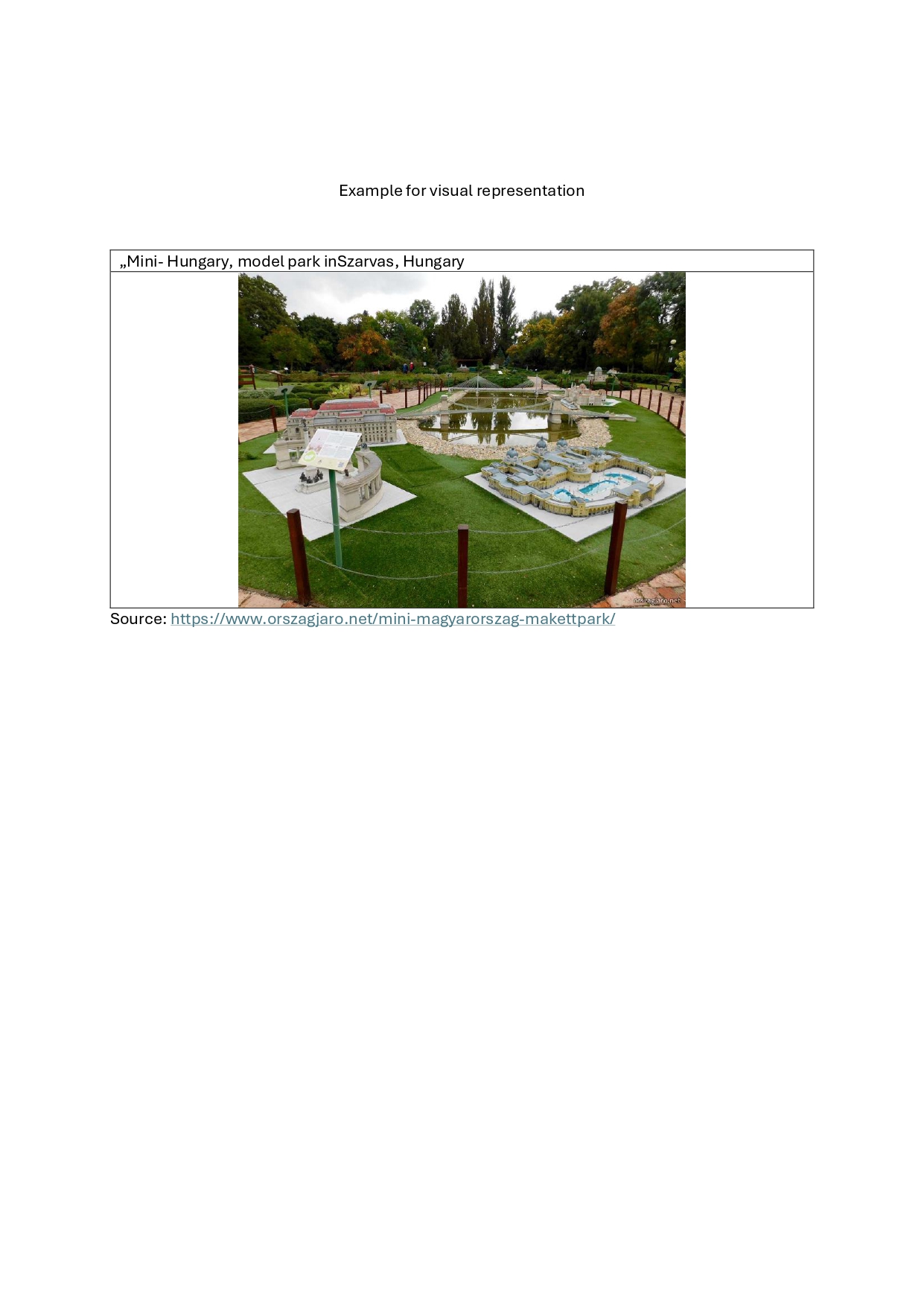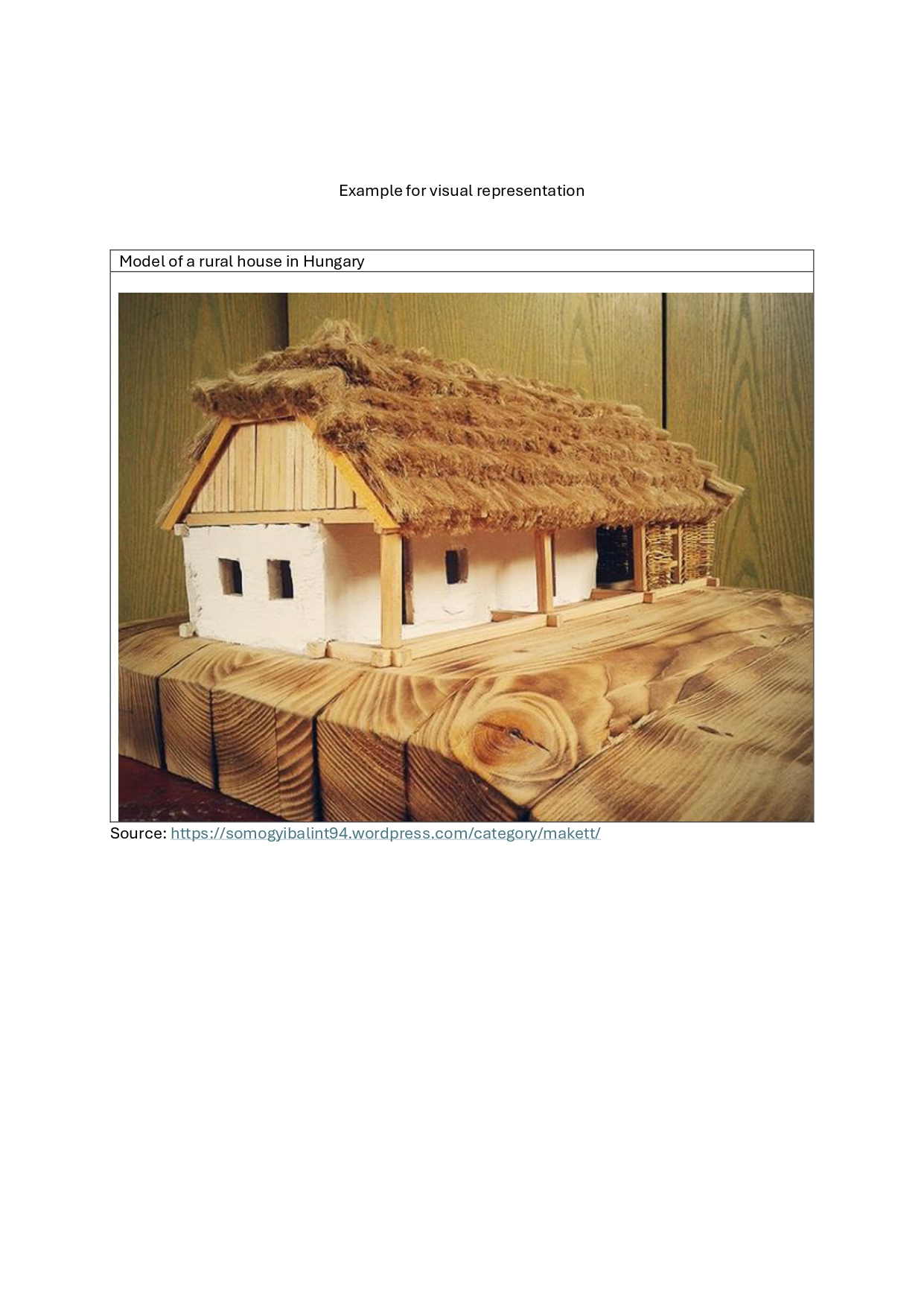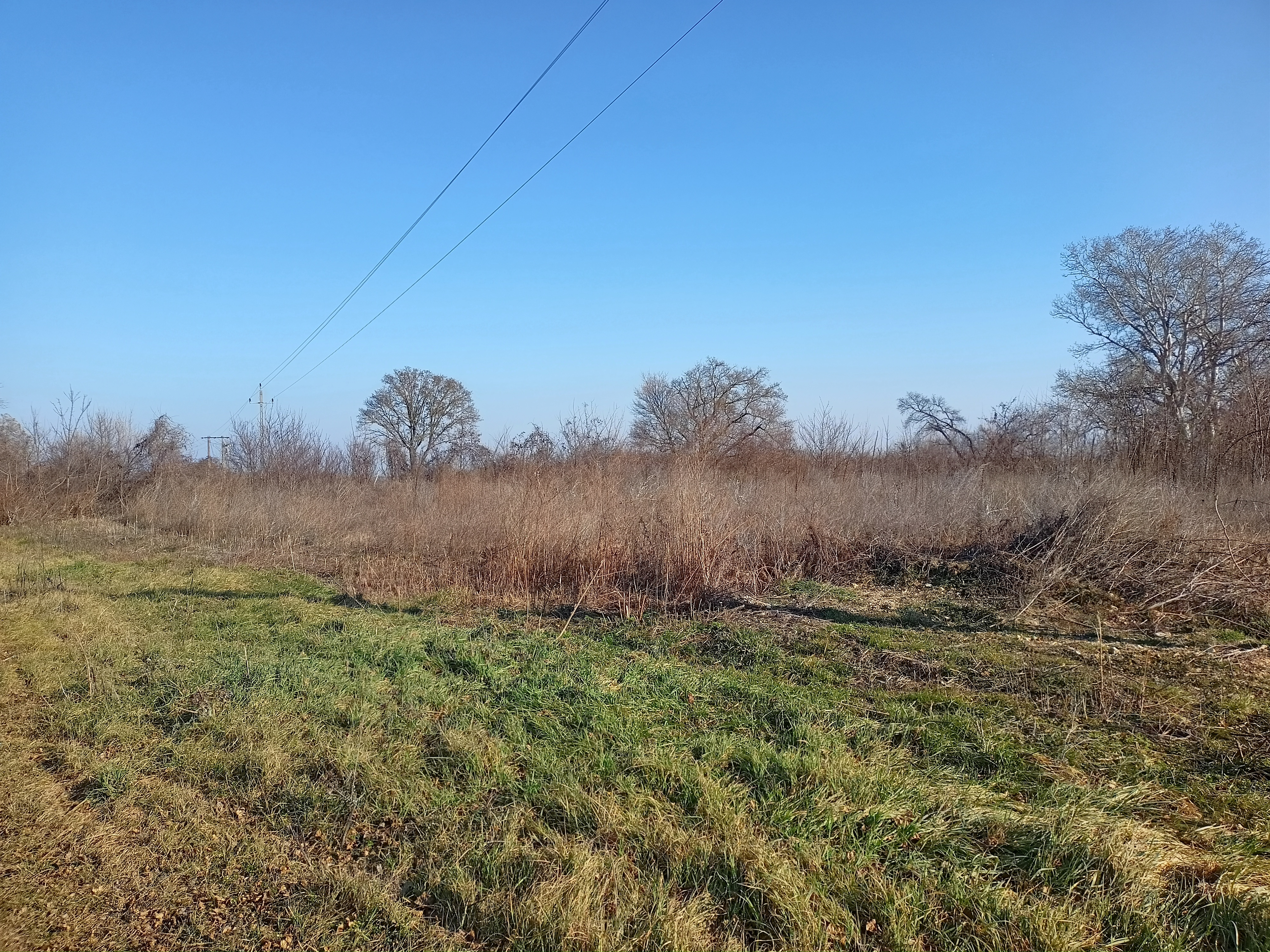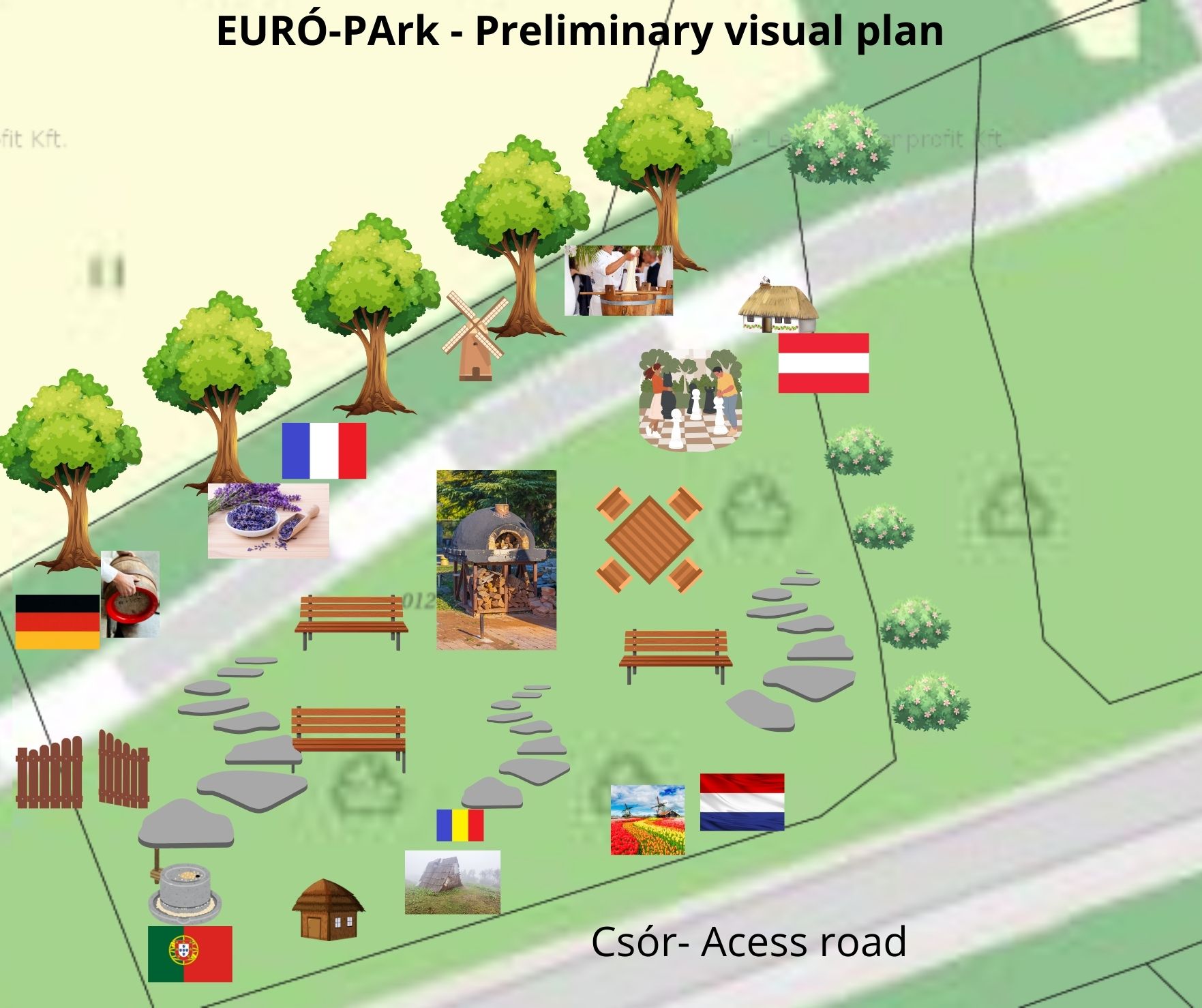EURÓ-PArk in Csór
EURÓ-PArk - the creation of a leisure park to showcase the diversity of European rural life in Csór
The village of Csór in Hungary, with a population of 2000 inhabitants, is located on the eastern slope of the Bakony Mountains. The project aims to establish the EURÓ-PArk in a previously unmaintained area. The park would feature models of rural assets (typical buildings, technologies) from different European countries, and the typical traditional way of life of. As a community space, it could be the venue for cultural and gastronomic events for local people, neighbouring villages and twin towns
Hungary
Csór, 0124/5
Early initiative
Yes
Yes
Yes
No
No
09779: Csór (HU)
The goal is to create a multifunctional leisure park on a previously unmaintained plot of land in the countryside, owned by the municipality. The site is located on the outskirts of the municipality, 300 metres from the main road 8, between the slightly isolated suburban part of the village (Szőlőhegy) and the inner area. The aim is to organise the unused area, to give it a function and to connect the population of the suburbs and the interior. The function is to create a community space that presents the values of a diverse rural Europe and makes it tangible for local residents and visitors. The park will feature models of the rural culture, lifestyle and customs of each Member State, with a walk through them to learn about a traditional aspect of the diverse European way of life.
In the central part of the park, a cooking area will be set up to host community events and celebrations of the gastronomic traditions of the Member States. In addition, there will be an open-air playground with games specific to each region (e.g. swinging bowls, giant chess, petanque, etc.) and benches for relaxation.
The target group will be mainly the local population and the surrounding area, with particular attention being paid to linking the outlying and "inner" population of the village, which is already an important part of the community planning process. On a wider scale, the municipality od Csór would like to involve the surrounding municipalities and then build a network between their twin municipalities in other Member States, as well as involving young people residing in the region as part of the EVS programme. In the long term, this networking can ensure that the project is not only a place for local residents to spend their leisure time, but also that the space is filled with regular and meaningful programmes that reflect the diversity of rural Europe.
In the central part of the park, a cooking area will be set up to host community events and celebrations of the gastronomic traditions of the Member States. In addition, there will be an open-air playground with games specific to each region (e.g. swinging bowls, giant chess, petanque, etc.) and benches for relaxation.
The target group will be mainly the local population and the surrounding area, with particular attention being paid to linking the outlying and "inner" population of the village, which is already an important part of the community planning process. On a wider scale, the municipality od Csór would like to involve the surrounding municipalities and then build a network between their twin municipalities in other Member States, as well as involving young people residing in the region as part of the EVS programme. In the long term, this networking can ensure that the project is not only a place for local residents to spend their leisure time, but also that the space is filled with regular and meaningful programmes that reflect the diversity of rural Europe.
community space
rural life
models
gastronomy
interconnectivity
The site selected for the project (Csór, 0124/4) is about 2700 square meters, formerly connected to the old main road no. 8. It is located along the access road to the current main road No. 8. The land is a municipality ownership but will not be marketable for about 8 years and cannot be used for industrial activities or residential development. There are no woody plants on the site, which is scrubby, bushy an unkept. Its location is very favourable, as it is easily accessible from the centre of the village and from the main road, the county town. On the other hand, its natural environment is characterised by the fact that the eastern slopes of the Bakony Mountains begin behind the area. The unity of the village with nature and long-term sustainability of the area are also important to maintain the essentially green-belt of the site, while at the same time providing a cohesive force for the community through its multiple function.
The aim is to present characteristic features of rural Europe in the form of models, whether it is a Bavarian farm, a Scandinavian fishing hut, an Italian olive mill or the work of Romanian shepherds. We believe that learning about the specificities and customs related to rural life also helps inhabitants to rediscover and maintain their own local values, connects them with people of other nationalities, and experiences the a community space have a cohesive effect.
During the planning and implementation of the project, we rely heavily on the work and ideas of local and nearby civil societies and residents, and we plan the design of the models in several stages, continuously expanding the range of countries and customs that can be presented year after year. In the long term, network expansion (twin towns, EVS) will also ensure that we can organise programs that offer cultural experiences for locals and visitors alike.
The aim is to present characteristic features of rural Europe in the form of models, whether it is a Bavarian farm, a Scandinavian fishing hut, an Italian olive mill or the work of Romanian shepherds. We believe that learning about the specificities and customs related to rural life also helps inhabitants to rediscover and maintain their own local values, connects them with people of other nationalities, and experiences the a community space have a cohesive effect.
During the planning and implementation of the project, we rely heavily on the work and ideas of local and nearby civil societies and residents, and we plan the design of the models in several stages, continuously expanding the range of countries and customs that can be presented year after year. In the long term, network expansion (twin towns, EVS) will also ensure that we can organise programs that offer cultural experiences for locals and visitors alike.
Cleaning up an unattended area is a starting point that has a positive impact on the settlement and the daily lives of the people living here. When designing a community space, we plan together with local residents and civil organizations models that will be displayed. The selection of these models is an important part of the cultural discovery process, as it is through joint reflection and by seeking the advice and experiences of others that we can identify the characteristics and customs of each area that are worth displaying. After all, we know very little about the way of life of other peoples, often we only know the capital or one or two of the most famous buildings of a country. During the project implementation, we are also asking for the help of local artisans to make the exhibited miniature models unique. The layout of the community space will be developed within the framework of a community design day, which has been successfully used locally, thus it will be implemented in accordance with the aesthetic expectations of the local people.
In recent years, several local projects have been implemented in Csór, thanks to the voluntary work of local people, as a completely grassroots initiative. Local volunteers built pergolas, tidied up the cemetery, installed some benches or solar lights in public spaces, civil societies have paved the streets with the help of teenagers. We would also like to use these examples in the construction of EURÓ-PArk. Because we experienced that participants not only enjoy co-creating, but they also develop positive emotions, such as feeling important in the local community, feeling that they have an influence on their local environment, and that they can do something useful beyond to their daily work and chores. This also affects individual self-confidence, provides a sense of community and strengthens the belief in democracy when people feel that decisions are not made far away, over their heads, but together with them.
In recent years, several local projects have been implemented in Csór, thanks to the voluntary work of local people, as a completely grassroots initiative. Local volunteers built pergolas, tidied up the cemetery, installed some benches or solar lights in public spaces, civil societies have paved the streets with the help of teenagers. We would also like to use these examples in the construction of EURÓ-PArk. Because we experienced that participants not only enjoy co-creating, but they also develop positive emotions, such as feeling important in the local community, feeling that they have an influence on their local environment, and that they can do something useful beyond to their daily work and chores. This also affects individual self-confidence, provides a sense of community and strengthens the belief in democracy when people feel that decisions are not made far away, over their heads, but together with them.
Csór is located in a well-developed region of Hungary, between two large cities. The proximity of the big cities and good accessibility of the area is good for the livelihood of the people living here, many of whom actually only go home to sleep. This is not conductive to community cohesion, nor does it foster traditional village life and values. The project aims to change another important problem, the spatial and social separation of the vineyards in the outskirts and the inner area. In several public forums initiated that it would be good idea to create a community space outside the village. The EURÓ-PArk is planned to be implemented in just such an area, which could be a bridge between social groups.They highlight the advantages of rural life and make it possible for people for people living here to discover that Europe is not only made up of big cities and famous buildings, but they can also learn about the rural values, traditions and customs of other countries. Learning about them makes people more tolerant and inclusive. EURÓ-PArk is located in an area that is easily accessible by public transport and by car. The municipality plans to create a parking lot on the adjacent plot. Both the car park and the park itself will be easily accessible. In the long term, the municipality is looking to develop technologies that assist people with visual or hearing impairments. The park will be accessible to everyone and can be visited free of charge. In addition to grant funding for the implementation of programmes and events organised with the involvement of international partners, the municipality will also rely on the voluntary work of local communities in order to ensure that there will be no additional financial burden for residents. At the same time, small-scale producers and local artisans from the region can sell their products during the events, so the project can also generate income to contribute to the funding of the next program, and to the maintenance costs.
The need for an outdoor community space has been expressed repeatedly in local public forums, both by the ‘hill people’ living on the outskirts and by the residents of the inner area. The central area of the village does not have sufficient size to create a communal space due to the high level of built-up areas, and the spatial connectivity function cannot be achieved if all events are in the centre of the village.
During the planning and implementation of the project, the municipalty pay special attention to community planning, which not only has a positive impact on the tangible results, but also strengthens the commitment of the involved residents, groups and organisations to participatory democracy. Our civil partners have proven on several occasions that they are able to move and activate residents for local issues. For example, the renovation and expansion of a park and the restoration of the cemetery were carried out through community planning and social work. Several benches and solar lamps were placed on the public squares of the settlement at the initiative of the citizens from below, and volunteers flowered, painted and collected garbage on several occasions. The municipality therefore believes that the population is open to taking actions for its own environment, to express their opinion, to make suggestions and participate.
Community planning is carried out in several phases: (Photos of his initial steps are attached).
1. Citizens' Forum
2. Drawing competition
3. Voting on social media platforms
4. Community planning days (3 occasions)
5. Setting up of working groups
6. Final opinion on the plans
Regular activities within the framework of local civil societies (pensioners’ club, choir, vigilance guard, baby-mom club, gymnastics) and civic programs are an important way of reaching out to residents. There is a demand for street forums and local residents’ meetings, which can be publicised through leaflets and community portals.
During the planning and implementation of the project, the municipalty pay special attention to community planning, which not only has a positive impact on the tangible results, but also strengthens the commitment of the involved residents, groups and organisations to participatory democracy. Our civil partners have proven on several occasions that they are able to move and activate residents for local issues. For example, the renovation and expansion of a park and the restoration of the cemetery were carried out through community planning and social work. Several benches and solar lamps were placed on the public squares of the settlement at the initiative of the citizens from below, and volunteers flowered, painted and collected garbage on several occasions. The municipality therefore believes that the population is open to taking actions for its own environment, to express their opinion, to make suggestions and participate.
Community planning is carried out in several phases: (Photos of his initial steps are attached).
1. Citizens' Forum
2. Drawing competition
3. Voting on social media platforms
4. Community planning days (3 occasions)
5. Setting up of working groups
6. Final opinion on the plans
Regular activities within the framework of local civil societies (pensioners’ club, choir, vigilance guard, baby-mom club, gymnastics) and civic programs are an important way of reaching out to residents. There is a demand for street forums and local residents’ meetings, which can be publicised through leaflets and community portals.
This project is in the “early initiative ’ phase. Local residents were already present at the birth of the idea, expressing their demand for the development of the public space, the project site and the community space in the form of a public forum.
The municipality also want to involve local residents, civil societies and businesses in the six-step community planning process described in the previous section. Consultations with regional actors has started in the form of cultural cooperation between the 8 small settlements in the area. With the help of the other municipalities, we would like to establish the future twinning network, i.e. to directly involve partners at European level in the project. This phase occurs in parallel with the physical implementation. At the regional level, an important partner will be the Youth of Europe Association, which will also help young people from other countries to get involved in organizing the programs and events planned in the park. The regional centre is Székesfehérvár, from where we will be able to involve young people from educational institutions doing community service in secondary school through civil partners.
The municipality also want to involve local residents, civil societies and businesses in the six-step community planning process described in the previous section. Consultations with regional actors has started in the form of cultural cooperation between the 8 small settlements in the area. With the help of the other municipalities, we would like to establish the future twinning network, i.e. to directly involve partners at European level in the project. This phase occurs in parallel with the physical implementation. At the regional level, an important partner will be the Youth of Europe Association, which will also help young people from other countries to get involved in organizing the programs and events planned in the park. The regional centre is Székesfehérvár, from where we will be able to involve young people from educational institutions doing community service in secondary school through civil partners.
One of the main messages of the project is to show the diversity of rural Europe, the diversity of rural lifestyle, the customs related to traditional rural life in one place, arranged in an aesthetic environment, using models. We believe that these values need to be promoted both among local populations and actors at other levels. Many of us do not have sufficient knowledge of these topics, especially in other countries.
The implementation of this project and the realistaion of the professional programs, will require an in depth knowledge of geography, ethnography, agricultural history, architecture and gastronomy. The selection of the themes for the models will be the task of a team of people who are experienced in these disciplines. During the implementation, we rely on the help of local and regional artisans and craftsmen. The gastronomic programme will also involve representatives of the visiting twin villages to work together, as well as young people from different Member States who are studying or volunteering in the region.
The implementation of this project and the realistaion of the professional programs, will require an in depth knowledge of geography, ethnography, agricultural history, architecture and gastronomy. The selection of the themes for the models will be the task of a team of people who are experienced in these disciplines. During the implementation, we rely on the help of local and regional artisans and craftsmen. The gastronomic programme will also involve representatives of the visiting twin villages to work together, as well as young people from different Member States who are studying or volunteering in the region.
There are several initiatives that use models of famous buildings to showcase a region or a country. The biggest initiative of this kind is Mini-Europe in Brussels, but we can also mention smaller, local attractions, such as the Castle Park in Dinnyés in our region, which features the famous castles of historic Hungary in miniature. However, we think thatit is important to look beyond the justly famous buildings to how people have in the countryside live and work today, for which examples can be found in some regions, but there is no similar initiative for the whole of Europe. We would also like to stress that the EURÓ-PArk project is not intended as a tourist attraction! Its aim is primarily to transfer information and to bring cultures closer together, beyond the built environment, to form human communities, not only among local people, but also by getting to know other peoples. We also consider it an innovative approach to twinning, in connection with this project, they would like to achieve not only be bilateral relations, but also multi-directional cooperation and exchange of experiences between small villages in other countries with similar problems, related to our partners in the region.
At the heart of our methodological approach is community planning, which is a tried-and-tested tool among civil society partners involved in the development of the initiative. In the initial phase of the 5- to 6-stage process, with the involvement of the general public, we are seeking to reach out to specific groups of local and wider community (elderly people, entrepreneurs, parents with young children, schoolchildren, teenagers who may be involved in volunteering). A small group of people will be the ones who can actually be mobilised, forming mixed groups (according to age, occupation and social situation), and teh design work will be carried out in a structured and playful way, using the toolkit of “Design thinking”, in which teams will collect their ideas and present them to the other teams, involving a specialist in the field of to the given topic.
Before the implementation phase, the wider public will again be involved by presenting concrete plans. Then the concrete investment is made by assembling teams of professionals and volunteers that can be involved in the implementation.
Before the implementation phase, the wider public will again be involved by presenting concrete plans. Then the concrete investment is made by assembling teams of professionals and volunteers that can be involved in the implementation.
In Hungary, as in many other European countries, there is traditionally a village-city conflict, which can arise from stereotypes, different economic opportunities and the lack of mutual knowledge. We believe that the pandemic period has made many people realise how much more difficult it is to live in confinement in a metropolitan environment than in a rural, small village dwelling, close to nature. These experiences also lead to an increasing number of people moving from large cities to rural areas. At the same time, this process of suburbanisation is not accompanied by a new sense of attachment to the place of residence, a lack of familiarity with neighbours, and a lack of community ties. This can create tensions within a small village.
Due to the processes of globalization, many segments of our lives have become uniform, as we can do the same jobs, eat the same fast food, and get the same cultural impressions, wherever we live in the world. More and more people think that we have to slow down our lifestyles, try to consume local products instead of mass-produced from the other continent, not travel to far-off landscapes, but live in a way that is aware of and cares for our environment. The EURÓ-PArk project can also be a means of strengthening rural lifestyles and habits, pointing out how many people in Europe are getting on in rural areas. It is not only the international programmes, meetings and the experience of diversity that have a positive impact, but also the fact that the community can be strengthened during the planning and creation of a space that is created together. Strangers who do not communicate with each other - or only in online space - can become good neighbours, whether we are talking about the relationship between individuals, between the vineyard and the inhabitants between neighbouring communities or even twin settlements.
Due to the processes of globalization, many segments of our lives have become uniform, as we can do the same jobs, eat the same fast food, and get the same cultural impressions, wherever we live in the world. More and more people think that we have to slow down our lifestyles, try to consume local products instead of mass-produced from the other continent, not travel to far-off landscapes, but live in a way that is aware of and cares for our environment. The EURÓ-PArk project can also be a means of strengthening rural lifestyles and habits, pointing out how many people in Europe are getting on in rural areas. It is not only the international programmes, meetings and the experience of diversity that have a positive impact, but also the fact that the community can be strengthened during the planning and creation of a space that is created together. Strangers who do not communicate with each other - or only in online space - can become good neighbours, whether we are talking about the relationship between individuals, between the vineyard and the inhabitants between neighbouring communities or even twin settlements.
In Hungary, as in many other European countries, there is traditionally a village-city conflict, which can arise from stereotypes, different economic opportunities and the lack of mutual knowledge. We believe that the pandemic period has made many people realise how much more difficult it is to live in confinement in a metropolitan environment than in a rural, small village dwelling, close to nature. These experiences also lead to an increasing number of people moving from large cities to rural areas. At the same time, this process of suburbanisation is not accompanied by a new sense of attachment to the place of residence, a lack of familiarity with neighbours, and a lack of community ties. This can create tensions within a small village.
Due to the processes of globalization, many segments of our lives have become uniform, as we can do the same jobs, eat the same fast food, and get the same cultural impressions, wherever we live in the world. More and more people think that we have to slow down our lifestyles, try to consume local products instead of mass-produced from the other continent, not travel to far-off landscapes, but live in a way that is aware of and cares for our environment. The EURÓ-PArk project can also be a means of strengthening rural lifestyles and habits, pointing out how many people in Europe are getting on in rural areas. It is not only the international programs, meetings and the experience of diversity that have a positive effect, but also the fact that the community can be strengthened during the planning and creation of a jointly created space. Aliens who do not communicate with each other - or only in the online space - can be good neighbours, whether we are talking about the relationship between individual people, between the vineyard and the inhabitants of the inner area, or between the inhabitants of neighbouring communities or even twin settlements.
Due to the processes of globalization, many segments of our lives have become uniform, as we can do the same jobs, eat the same fast food, and get the same cultural impressions, wherever we live in the world. More and more people think that we have to slow down our lifestyles, try to consume local products instead of mass-produced from the other continent, not travel to far-off landscapes, but live in a way that is aware of and cares for our environment. The EURÓ-PArk project can also be a means of strengthening rural lifestyles and habits, pointing out how many people in Europe are getting on in rural areas. It is not only the international programs, meetings and the experience of diversity that have a positive effect, but also the fact that the community can be strengthened during the planning and creation of a jointly created space. Aliens who do not communicate with each other - or only in the online space - can be good neighbours, whether we are talking about the relationship between individual people, between the vineyard and the inhabitants of the inner area, or between the inhabitants of neighbouring communities or even twin settlements.
The activities of the project, in connection with the value system of the NEB, aim at the sustainable development and aesthetic transformation of the small settlement environment, while at the same time creating an inclusive community space presenting European values in a diverse way.
In community planning, we seek to involve as wide a range of local and regional residents, organisations and entrepreneurs as possible in shaping the development that will actually take space. The resulting innovative EURÓ-PArk is a concept that fits into the landscape, as it tries to showcase the diversity of European rural life in a unique way in the region, using a series of models. The inclusive approach is also reflected in the organisation of the programmes on several levels, the first level being the creation of a link between the inhabitants of the village centre and the inhabitants of the suburbs. The second level is to familiarize the surrounding small villages and the inhabitants of the region with the diversity of rural values, and at international level, through the civil societies linked to the EVS programme, and network with international partners of the small villages of the region, we can contribute to making the values formulated in the NEB programme tangible for as many people as possible.
In the first period of the project, we plan to build about 15 models, with a steady increase in the following years. So the creative work does not stop, year after year we would like to showcase the rural values of a new country, in a way that is easily accessible to the community, not as a one-off tourist attraction, but as a regular meeting place and gastronomic programme.
In community planning, we seek to involve as wide a range of local and regional residents, organisations and entrepreneurs as possible in shaping the development that will actually take space. The resulting innovative EURÓ-PArk is a concept that fits into the landscape, as it tries to showcase the diversity of European rural life in a unique way in the region, using a series of models. The inclusive approach is also reflected in the organisation of the programmes on several levels, the first level being the creation of a link between the inhabitants of the village centre and the inhabitants of the suburbs. The second level is to familiarize the surrounding small villages and the inhabitants of the region with the diversity of rural values, and at international level, through the civil societies linked to the EVS programme, and network with international partners of the small villages of the region, we can contribute to making the values formulated in the NEB programme tangible for as many people as possible.
In the first period of the project, we plan to build about 15 models, with a steady increase in the following years. So the creative work does not stop, year after year we would like to showcase the rural values of a new country, in a way that is easily accessible to the community, not as a one-off tourist attraction, but as a regular meeting place and gastronomic programme.

